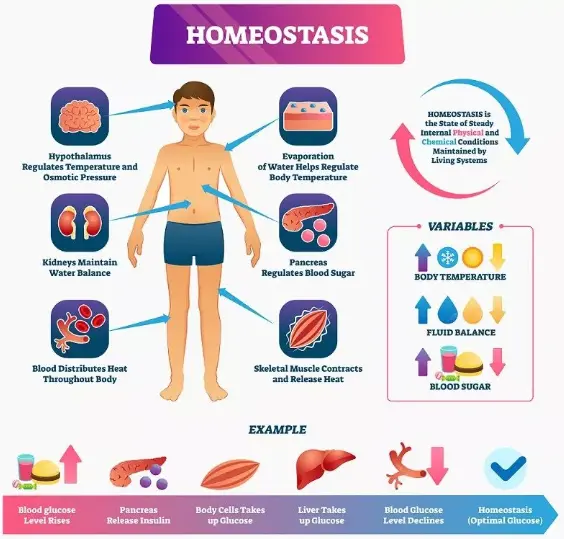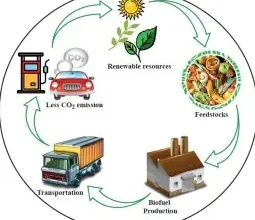Examples Of Homeostasis In The Body & In Everyday Life

Homeostasis is a crucial concept in biology that refers to the process by which organisms maintain a constant internal balance, despite changing environmental conditions.
Homeostasis:
Homeostasis refers to the body’s ability to maintain a stable internal environment despite external changes.
Various physiological processes work together to regulate factors such as body temperature, blood pressure, pH, and nutrient levels.

This balance is essential to ensure the optimal functioning of biological systems.
In the human body, there are several examples of homeostasis that illustrate how factors such as temperature, pH, blood glucose, and others are regulated to maintain a stable internal environment.
Examples Of Homeostasis In Everyday Life
Temperature homeostasis:
Body temperature is a classic example of homeostasis in the human body. The body maintains its temperature at approximately 37°C (98.6°F) to ensure optimal functioning of chemical reactions and metabolic processes. Temperature regulation is achieved through two main mechanisms:
- Sweating : When body temperature increases, the body responds by releasing sweat. Sweat evaporates on the surface of the skin, which dissipates heat and cools the body.
- Vasoconstriction and Vasodilation : When it’s cold, blood vessels narrow (vasoconstriction) to conserve heat. On the other hand, in hot climates, they widen (vasodilation) to release heat.
pH homeostasis
pH is a measure of the acidity or alkalinity of a solution. In the human body, maintaining blood pH within a narrow range is essential to ensure optimal functioning of enzymes and proteins.
The acid-base regulation system in the body controls blood pH through two main systems:
- Bicarbonate and Carbon Dioxide System : The bicarbonate and carbon dioxide system acts to neutralize excess acid or base in the body. The kidneys regulate the amount of bicarbonate excreted in the urine, while breathing controls the elimination of carbon dioxide.
- Balance of Hydrogen Sulfide and Ammonia : The body also uses the balance between hydrogen sulfide and ammonia to regulate blood pH. The kidneys play a fundamental role in regulating these compounds.
Blood Sugar (Glucose) Homeostasis
Regulating blood glucose levels is crucial to providing energy to cells. This is achieved through the action of two key hormones:
- Insulin : When blood glucose levels rise after a meal, the pancreas secretes insulin. Insulin facilitates the uptake of glucose by cells, thereby reducing blood sugar levels.
- Glucagon : When blood glucose levels decrease, the pancreas secretes glucagon. Glucagon stimulates the liver to release stored glucose as glycogen, thereby raising blood sugar levels.
Blood Pressure Homeostasis
The body regulates blood pressure to ensure adequate blood circulation and prevent damage to blood vessels. Blood pressure is controlled through several mechanisms:
- Vasoconstriction and Vasodilatation : Blood vessels narrow (vasoconstriction) or widen (vasodilation) depending on the body’s needs. This regulates resistance in the vascular system and, consequently, blood pressure.
- Heart Rate : The heart adjusts its rhythm and pumping force to maintain adequate blood pressure. Stimulation of the autonomic nervous system plays a key role in this process.
Water and Electrolyte Homeostasis
Water and electrolyte balance is essential for cellular function and hydration of the body. The water balance regulation system involves the kidneys, which adjust the amount of water and electrolytes eliminated in the urine.
Sodium and potassium are two key electrolytes regulated to maintain water balance.
Calcium Homeostasis in Bones
Calcium is a mineral essential for bone health, muscle function and cellular communication. Hormones, such as parathormone and calcitonin, control calcium levels in the body.
When blood calcium levels are low, parathormone stimulates the release of calcium from the bones. On the other hand, when they are high, calcitonin reduces the release of calcium from the bones.
Conclusion
Homeostasis is essential for the survival and optimal functioning of the human body. These examples illustrate how the body regulates temperature, pH, blood sugar, blood pressure, water, electrolytes, and calcium to maintain a constant internal balance.
Understanding these mechanisms is fundamental to medical practice and shows us the complexity and wonder of the human body.
Maintaining homeostasis is a continuous and delicate task that demonstrates the incredible adaptive and regulatory capacity of the human organism.
Also READ:
- Examples Of Biofuels In Economics And Their Uses In Daily Life
- 13 Different Types Of Energy And Their Definitions
- What Is The Difference Between Donkey And Mule?
- Difference Between Bacteria And Fungi With Tabular Form
- Difference between Centrifugal and Peripheral Pump And Their Parts
- What Are Carnivorous Animals? Examples And Characteristics
- Herbivorous Animals: Name, List And Examples With Pictures
